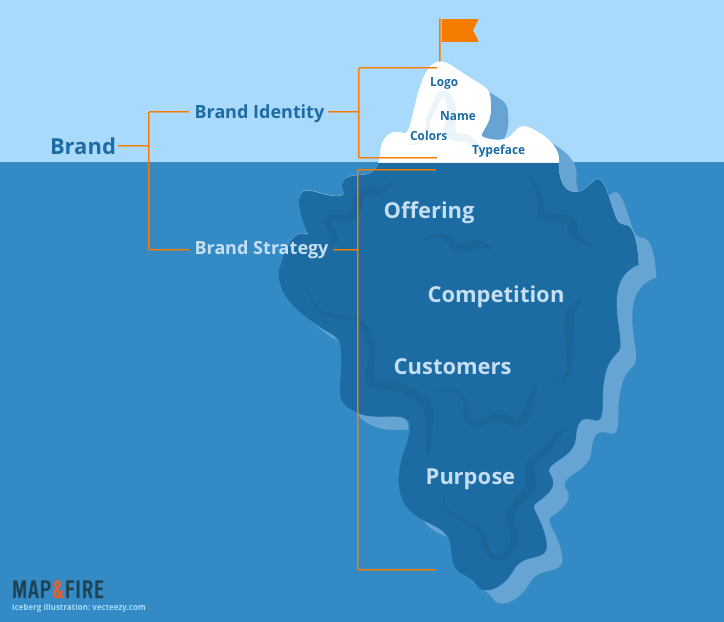
There’s a popular metaphor in the strategy world of comparing your company’s brand to an iceberg.
The idea is that your identity (name, logo, colors, and such) are like the visible “tip” of your brand.
Lying below the surface are the strategy elements that support and inform that identity.

This is an important mental model because it shows the relative weight those “hidden” elements have. It also highlights how your visual identity should be an extension of your brand strategy.
Whether you develop your visual identity by hand or with the help of awesome AI tools, you need to take those strategy elements into account.
The illustration above provides one more important piece of guidance about this:
Your brand isn’t just about what’s meaningful to you, but what will appeal to your customers.
Here are four key concepts to guide and inform your visual identity.
4 Elements of Your Brand’s Iceberg
1. Purpose: “Why do you have a business in the first place?”
Your purpose should be at the heart of all your brand decisions. It speaks to why you decided to start a business at all. What does it provide for you and what does it provide for others?
It’s the most personal component of this entire equation.
Interestingly, it’s a piece that sometimes gets overlooked or taken for granted. We often have an intuitive sense of that purpose but it’s important to articulate it.
If you want a brand identity that aligns with who you are and what you hope to accomplish, you need to have a clear idea of your brand’s purpose.
2. Customers: “What important need are you addressing for people?”
This is another concept that sometimes gets overlooked. It sounds obvious, but the number one reason most startups fail is “lack of market demand”.
In other words, the need wasn’t strong enough.
Validating this for your own business is critical for its survival. Does your business solve a problem that’s important and frequent, and affects a large number of people?
From an identity perspective, you need to make sure you express your brand in visuals and words that align with that important need.

3. Competition: “What unique position will your business occupy in your customer’s mind?”
If you’ve identified an important need for customers, then there’s no doubt they’ll have additional ways to satisfy it.
In other words, it doesn’t matter how innovative your business is, you always have competition.
Your customers may solve the need themselves or use solutions outside your industry. But if it’s important enough they’ll find alternatives.
The question then is, how will you stand out among those other options? How do you create a unique position?
Do you differentiate around functional elements like price, quality, and efficiency? Or do you focus more on emotional elements? Or is it even aspirational in that it helps customers realize an ideal version of themselves?
Your brand identity needs to align with those points so that it’s clear to customers how you’re different.
Your identity will provide a mental shortcut for customers so that it’s easy to remember that unique position.
4. Offering: “How do you deliver on your customer’s important need?”
Finally, you need to deliver a solution for that important need in a unique way.
Your offering is where the rubber meets the road. It’s where you execute on your position through features that satisfy your customer’s needs.
Does your offering deliver on its promise? Does your brand reflect what you’re offering?
Once again, your brand identity should align with the specific attributes of your offering.
It should be easy for customers to create a mental connection between what you do and what they see, read, and hear about you.

Listen to Your Customers to Shape Your Iceberg
When it comes to your brand and identity your thinking needs to be informed by your target customers.
It doesn’t matter if you have the most amazing product or service in the world. If people don’t connect with your brand they probably won’t become customers.
Take the time to think through these strategy elements and make sure you have a good fit between what your business does and its identity.
The stronger that fit, the better you’ll embed your brand in the minds of people and turn them into loyal customers.


